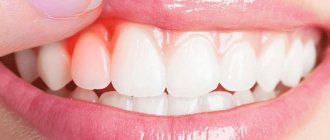This is a fairly common disease that can occur in both children and adults, but the former are more often affected by it. In any case, it is important to know how to quickly cure a sore throat in order to quickly alleviate the patient’s condition and to prevent the development of complications. Despite the prevalence of the disease and, it would seem, a lot of known methods of treating it, you should not neglect medical help. To understand the insidiousness of the disease, you should learn more about it - what it is, what types there are and what methods of elimination are used.
This is what you will learn about sore throat and its treatment by reading this article
- What is a sore throat?
- Types of sore throat, symptoms, treatment
- Catarrhal sore throat
- Symptoms
- Treatment
- Follicular tonsillitis
- Symptoms
- Treatment
- Lacunar tonsillitis
- Symptoms
- Treatment
- Fibrinous tonsillitis
- Symptoms
- Treatment
- Quinsy
- Symptoms
- Treatment
- Herpangina
- Symptoms
- Treatment
- Ulcerative membranous tonsillitis
- Symptoms
- Treatment
- Traditional medicine in the treatment of sore throat
- Treatment of sore throat with antibiotics
- Complications of sore throat
- When should you call an ambulance?
- Nutrition for sore throat
- Mistakes in the treatment of sore throat
What is a sore throat?
This is a disease of infectious origin, occurring in an acute form. Its causative agent is usually bacteria (most often the disease is caused by beta-hemolytic streptococcus, staphylococcus). But viruses and fungi can provoke the disease. How to quickly cure a sore throat depends on what kind of microorganisms it is caused by, because only those drugs that can act directly on them will be effective.
The infection affects the palatine tonsils, causing them to become inflamed, which is accompanied by the accumulation of pus, swelling, and difficulty breathing. In medicine, the disease is also known as acute tonsillitis. Considering that it is infectious, tonsillitis is contagious and is transmitted by airborne droplets, through household items, and food.
how to treat a sore throat
For reference. The tonsils are lymphatic tissue that is part of the pharyngeal ring. Thanks to them, peripheral immunity is formed, they protect the body from infections.
Back to Contents
Types of sore throat, symptoms, treatment
Depending on the course of the disease, its symptoms, its varieties are as follows:
- Catarrhal;
- Follicular;
- Lacunarnaya;
- Fibrinous;
- Phlegmonous;
- Herpetic;
- Ulcerative-membranous.
General signs of the disease are:
- Pain in the throat, which is sharp and intensifies during conversation, when swallowing;
- Fever (depending on the type of illness and the severity of its course, it can reach 40 degrees);
- General weakness of the body, severe muscle weakness;
- Headache;
- Redness of the tonsils and mucous membranes of the throat;
- The appearance of white plaque on the tonsils, their enlargement.
In the first stages of the disease, it can be confused with the flu or a cold, although it is more severe. The main symptom that can be used to suspect a sore throat is severe pain in the throat, which makes it difficult to speak, eat, and breathe.
The most important thing in how to get rid of a sore throat quickly and effectively is an integrated approach. What must be included in the process?
- Bed rest. Without it, therapy may be ineffective, and this is fraught with complications;
- It is important to follow a certain diet;
- The patient needs to drink plenty of fluids, which will help fight the infection faster;
- Be sure to gargle using special preparations;
- Medicines with antihistamine and anti-inflammatory effects can be used. If the disease is of bacterial origin, then the use of antibiotics will be required. The choice of group of drugs depends on the causative agent of the disease.
In some cases, if there is a risk that the patient may suffocate and/or the infection spreads to neighboring organs, surgical intervention may be required.
Back to Contents
Catarrhal sore throat
This is a type of acute tonsillitis, which is one of the mildest forms of the disease. It is an inflammation of the mucous membrane of the throat and often develops against the background of reduced immunity of the patient. Considering that the body’s defenses usually decrease in the autumn-winter period, this disease also often attacks precisely during this season.
The catarrhal type of the disease is characterized by a high percentage of transmission, but patients tolerate it much faster and easier than other types of tonsillitis.
Symptoms
Signs of catarrhal tonsillitis usually appear quickly - the incubation period ranges from several hours to 2-3 days. Its symptoms are:
- Enlargement of the tonsils and their acquisition of a bright red color, severe swelling;
- The presence of a translucent film-like coating on the tonsils;
- Difficulty swallowing;
- Sore, dry throat;
- Increased body temperature. It is not always significant - the temperature can rise to 37.2, but it is possible that it will rise to 39 degrees. Often this symptom is accompanied by body aches and weakness.
Symptoms such as dizziness, nausea, vomiting (signs of intoxication) occur less frequently. If a patient has a white coating on his tongue, a doctor during a face-to-face examination can most likely assume that the causative agent of the disease is bacteria.
Treatment
Due to the high rate of disease transmission, the patient should be isolated. As for how to treat catarrhal tonsillitis, it is important to use a set of measures:
- Drink plenty of fluids;
- Due to the fact that it is painful for the patient to swallow, during treatment he should switch to pureed, liquid food;
- Bed rest is mandatory;
- To eliminate the inflammatory process and pain, sprays are prescribed (Hexoral, Orasept, Faringo-spray);
- In the absence of intoxication of the body, drugs of the sulfonamide group (Streptotsid, Septrin, Biseptol) are prescribed;
- If the temperature reaches 38 degrees or more, antipyretic medications are used (Paracetamol, Ibuprofen, Cefekon);
- The doctor may also prescribe medications with antiallergic effects (“Loratadine”, “Suprastin”, “Diazolin”);
- A good therapeutic effect is obtained by gargling, for which solutions with hydrogen peroxide, boric acid, and calendula infusion are used. The lacunae of the tonsils should be washed using an iodine solution.
how to cure a sore throat
You can cure a sore throat without antibiotics - the listed remedies are quite capable of dealing with it. Recovery can be achieved within a 6-7 day period. But if the bacterial origin of the disease is confirmed and the listed set of methods does not help, then the doctor prescribes antibiotics.
Follicular tonsillitis
This is a purulent type of the disease, characterized by a severe course. This type of inflammatory process is most often provoked by streptococci and staphylococci. Children and adolescents are most susceptible to the disease. Considering the nature and severity of the disease, how to treat purulent sore throat is a task whose solution should be entrusted to a doctor.
Back to Contents
Symptoms
The disease manifests itself acutely, rapidly, but not always with a sore throat, as is the case with many other types of tonsillitis. The first signs are similar to flu and colds - chills due to elevated temperature, muscle pain, headaches, body aches. Following these manifestations, the following symptoms of follicular tonsillitis begin to make themselves felt:
- Pain in the throat, which can radiate to the temple or ear when swallowing or talking;
- Enlarged lymph nodes, and in many patients they become so large that they feel them, and turning the head is accompanied by pain;
- A sign directly characteristic of follicular tonsillitis is the appearance of small purulent spots on the palatine tonsils, which are white or light yellow in color. On the affected areas they appear as bubbles;
- Due to the presence of pus, the patient develops an unpleasant taste in the mouth, as well as bad breath.
Treatment
It is necessary to exclude the patient’s physical activity and maximize the amount of fluid he consumes (tea, water). A set of measures used to quickly cure follicular tonsillitis includes:
- The insidiousness of the disease lies in the fact that it can provoke the development of a runny nose and the accumulation of purulent discharge in the nose. Therefore, in addition to antiseptic throat sprays (Iodinol, Ingalipt, Hexoral), you should also use nasopharynx cleansers (for example, Dolphin);
- Inhalation with eucalyptus helps eliminate the infection, but it is recommended to use them if the patient does not have a fever;
- It is not always possible to cure purulent (follicular) sore throat without antibiotics. The most effective in this case are representatives of the penicillin group (“Penicillin”, “Amoxicillin”);
- Furacilin solution removes purulent “sacs” well;
- If the patient is bothered by a high temperature, one cannot do without drugs that have an antipyretic effect (“Citramon”, “Paracetamol”, “Aspirin”);
- It is often necessary to use antihistamines.
Due to the fact that children often become patients with follicular tonsillitis, an important question for parents is how to treat a child’s sore throat at home. The listed methods contribute to this, and it is recommended to add to them the use of Faringosept and Doctor Mom lozenges, which help soften the tissues of the throat and eliminate purulent spots.
Lacunar tonsillitis
The palatine tonsils have many depressions called lacunae. These depressions with their branches extend into the lymphoid tissue. Lacunar tonsillitis affects lacunae and has an external resemblance to follicular tonsillitis. Both types can develop simultaneously, and for an inexperienced person it is almost impossible to visually determine the type of inflammation and distinguish one from the other.
Children and adolescents are most often affected by the disease, and in people over 50 years of age it is much less common.
Symptoms
The disease develops rapidly, and within the first day all its signs appear:
- High temperature, which can be 38-41 degrees. Without this symptom, the disease rarely occurs;
- The appearance of exudate on the surface of the mouths of lacunae. It appears as a coating in the form of small yellowish islands. This is a characteristic sign of the lacunar variety of the disease, which is similar to the main symptom of follicular tonsillitis;
- Bad breath, bad taste;
- Redness of the cheeks with noticeable pallor in the area of the nasolabial triangle (another sign accompanying lacunar tonsillitis itself);
- Sore throat when swallowing or talking.
The remaining symptoms of the disease are nonspecific and include headache, muscle pain, general malaise, pain in the jaw area, and loss of appetite.
Treatment
As with other types of sore throat, bed rest and plenty of warm fluids are required. If lacunar tonsillitis strikes, how to quickly cure it will depend on what measures are taken for this. And the following are effective:
- Antibacterial rinses (Biclotymol, Miramistin, Chlorhexidine) are used as local therapy;
- Regardless of whether the task is to cure lacunar tonsillitis in an adult or cure lacunar tonsillitis in a child, it is necessary to identify its causative agent. In accordance with this, the main method of therapy is selected. If it has a viral etiology, antiviral medications are used (Kipferon, Viferon). Antibiotics of the penicillin group (Amoxiclav, Amoxicillin, Phenoxymethylpenicillin) are effective in the fight against bacterial lacunar tonsillitis. If the disease is caused by fungi, the use of Lugol's solution, Fluconazole is indicated;
- If the patient has an allergic reaction to the medications used, you need to resort to antihistamines (Cefditoren, Cefixime);
- If treatment with the listed antiviral, antifungal, and antibacterial drugs is impossible, alternative antibacterial agents (Azithromycin, Clindamycin, Josamycin) are prescribed.
Back to Contents
Gargling for the treatment of sore throat in adults
Gargling - this method of treatment plays one of the main roles in the healing process. Thanks to daily rinsing, all harmful bacteria and pus are washed out of the mouth and larynx. Pain in the throat also decreases, resulting in an improvement in the overall condition of the body.
- a mixture of natural beet juice and table vinegar is considered a unique remedy against germs and infections. This solution, when rinsed, has an anti-inflammatory effect and relieves pain when swallowing.
- Honey water is good for gargling (warm drinking water and a few spoons of honey), mix, use for gargling several times a day;
- medicinal mixture: squeeze the juice out of carrots and add a few cloves of garlic, grated on a fine grater. Take the mixture before meals for two or three days;
- treat inflamed tonsils with a mixture of onion and honey. Grate a small onion, squeeze out the juice, add a teaspoon of natural honey to it. mix everything thoroughly. The healing composition is ready!
- medicinal mixture: a teaspoon of honey and the same amount of aloe juice, mix. Take several times a day before meals;
- Beetroot, which is rich in vitamins and microelements, has a beneficial effect on the body and on the source of inflammation. Squeeze fresh beet juice or boil it in a small amount of water; gargle well with natural juice or beet broth. Beets perfectly eliminate swelling on the mucous membranes of the throat, pain and are effective against purulent phenomena in the tonsils;
- Warm honey-milk composition is a well-known way to get rid of sore throat, inflammation in the larynx, colds and coughs. Dissolve a little honey in a glass of warm milk and add butter for a more softening effect.
An important condition is the optimal temperature of the prepared solution: it should be within 35 - 40 degrees. It is not recommended to consume drinks or food after the end of the treatment session. Their reception is allowed half an hour after the procedure.
Fibrinous tonsillitis
Often this type of disease develops as a consequence of follicular or lacunar tonsillitis. It is difficult and the patient’s condition worsens significantly, especially if it is not treated in a timely manner.
Symptoms
Most of the signs of the disease are typical for sore throat - sore throat, muscle pain, inflammation of the lymph nodes, fever, fatigue. Characteristic symptoms for fibrinous tonsillitis are:
- The appearance of a gray film-like coating on the throat and tonsils. This kind of plaque occurs with diphtheria. In the absence of complications, it is easily separated without bleeding;
- If candidiasis or mononucleosis joins the disease (which often happens), it acquires a yellowish tint. In this case, there may be problems with removing plaque;
- Severe course of the disease, the appearance of complications may be accompanied by symptoms such as suffocation, severe swelling of the nasopharynx, disturbances in heart rhythms, and pain in the eyes.
Treatment
It will be difficult to get rid of the disease without the intervention of a doctor, and there is no need to take risks. How to quickly cure a sore throat in an adult and a child if it has acquired a fibrinous form?
- Be sure to maintain drinking and bed rest - there should be plenty of rest and fluids;
- In addition to traditional antiseptic rinsing solutions (iodine-containing medications, Furacilin, Chlorhexidine), you can use herbal decoctions based on sage and chamomile;
- To get rid of the disease, it is important to normalize blood circulation in the throat area, which is done with the help of compresses. A towel, previously soaked in cool water and wrung out, should be wrapped around the throat, carefully insulating it on top with a scarf or blanket. It is recommended to keep the compress for about an hour, and carry out the procedure three times a day;
- Severe disease will require the use of sulfonamides and penicillins;
- During treatment, it is advisable to consume as many foods and drinks as possible containing vitamin C - it helps destroy pathogenic microorganisms.
First aid for incipient sore throat
As a measure to prevent the development of the disease, a solution of water with salt and iodine is used to gargle. For 200 ml you need half a teaspoon of salt and a couple of drops of iodine. Rinse every 2-3 hours. Fusafungine antiseptics will help slow the spread of bacteria in the early stages. If there is an increase in temperature above 38 degrees, then it should be brought down with Paracetamol or Ibuprofen.
Read in detail about antibiotics for sore throat in adults in tablets here.
Quinsy
In medicine, the disease is also known as paratonsilitis or paratonsillar abscess. It usually develops as a consequence of other types of tonsillitis - a couple of days after the end of the disease. The disease affects the peri-almond tissue and is characterized by a severe course.
Symptoms
The disease begins with the same manifestations as other forms of tonsillitis. But the pain in the throat is acute and pronounced. Other characteristic symptoms of the disease:
- Severe redness of the ocomandal tissues, their swelling;
- The tonsil may be displaced, protruding above the level of the niche;
- Enlarged lymph nodes in the neck;
- Increased salivation;
- A pronounced nasal tone may appear;
- It is often impossible or very difficult to open your mouth completely.
Treatment
When the disease occurs, pus accumulates, often on one side, above the upper part of the tonsil. Antibiotics can be used for therapeutic purposes, and analgesics, antihistamines, and antipyretics can be used to alleviate the patient’s condition. But the main method of treatment, if phlegmon (accumulation of purulent discharge) develops, is the surgical method.
Herpangina
The causative agents of this disease are usually enteroviruses. It can also be a complication of the flu. The external similarity of the ulcers covering the tonsils was the reason for this name of the disease. Children aged 3-10 years are most susceptible to the disease.
Symptoms
The first manifestation of herpetic tonsillitis is general weakness and fever. The following signs make themselves felt:
- Pain in the throat;
- Upon examination, the patient reveals a rash on the tonsils in the form of blisters with grayish contents. The tissues of the pharynx themselves become red;
- Difficulty swallowing;
- Pain in the area of the cervical lymph nodes;
- Children under 4 years of age do not always experience a sore throat, but the child may lose appetite due to colic and nausea.
Treatment
The course of the disease is usually not severe, but this does not mean that it can not be treated. Treatment of sore throat at home can be carried out using the following measures:
- Drink plenty of fluids, bed rest;
- The use of antipyretic medications (for example, Ibuprofen, Nimesulide);
- The use of antihistamines (Claritin, Loratadine, Zyrtec);
- Gargling with antiseptic agents (“Cameton”, “Yox”, “Inhalipt”);
- The use of antiviral drugs (Viferon, Tsitovir, Cycloferon).
Back to Contents
Treatment
To avoid infecting others, you need to stay at home if treatment for sore throat will be carried out at home, or quickly go to the hospital if therapy involves a hospital stay.
The room should be ventilated as often as possible, and if possible, ultraviolet irradiation and wet cleaning should be carried out. Dishes and towels must be strictly individual.
Therapy for tonsillitis includes the creation of a gentle regime, general and local therapy.
Gentle mode
- At the beginning of the illness and the first couple of days after the temperature normalizes, it is better to stay in bed1. Then, when the fever goes away, you need to stay home and avoid physical activity.
- Increased temperature promotes increased sweating. Drinking plenty of drinks - will help reduce the symptoms of intoxication and avoid dehydration . Traditional treatment of sore throat with milk and honey is contraindicated. Sweet milk is an ideal breeding ground for bacteria; they multiply quickly, and this aggravates the course of the disease1.
- Food must be thermally processed, liquid or crushed, unsalted and unsweetened, without the addition of spices and spices1. It is better to choose easily digestible vegetable and dairy dishes with a low content of simple carbohydrates, boiled, stewed, steamed1.
Systemic drug therapy
Regardless of the severity of the condition, streptococcal tonsillitis is an indication for antibiotic therapy in the form of tablets or injections1,2,4. Therefore, if you have a sore throat, you should consult a doctor.
Antibiotics are especially important in the treatment of sore throat in children and people with weakened immune systems. They help prevent the development of complications2.
The choice of antibiotic and its dosage is determined by the doctor. In particular, beta-hemolytic streptococcus is sensitive to the latest generation of penicillin and macrolides1,2. The duration of treatment for sore throat with fever in both adults and children is on average 7 days2. Severe condition is an indication for hospitalization in an infectious diseases hospital, injection or drip administration of antibiotics2.
Antibiotics kill not only pathogenic bacteria, but also beneficial microflora of the oral cavity and digestive tract, which can trigger the development of candidiasis. To prevent it, antifungal drugs . They are also used to treat fungal tonsillitis, which usually occurs in patients with severely weakened immunity, for example, due to AIDS or taking medications that suppress the immune system2,5.
Non-steroidal anti-inflammatory drugs help to quickly stop the inflammatory process and fever, and reduce pain in the throat.
Desensitizing drugs are indicated to prevent allergies and autoimmune complications2.
Local therapy
Gargling with saline (sea salt, soda) solutions and antiseptic solutions helps to speed up the cleansing of the tonsils2,3. Traditional medicine suggests using infusions and decoctions of medicinal plants, for example, chamomile or calendula. Traditional medicine has more effective means - special preparations for gargling2,3, such as HEXORAL®. In the treatment of mild forms of viral tonsillitis, they are used as the main remedy to prevent the development of bacterial inflammation of the tonsils3, in other cases they become an addition to systemic antibacterial therapy.
The main active ingredient of the preparations HEXORAL® SOLUTION and HEXORAL® AEROSOL is the antiseptic hexetidine, which has antiseptic, antifungal, analgesic, hemostatic and deodorizing effects6.
HEXORAL® solution/aerosol:
- active against gram-positive bacteria, which include bethemolytic streptococcus, and fungi of the genus Candida, which are activated when immunity is reduced and antibiotics are used6;
- has a high safety profile, due to which it can be used not only in adults, but also in children from 3 years old6;
- relieves painful sensations when swallowing6;
- valid up to 12 hours6.
HEXORAL® TABS and TABS CLASSIC contain antiseptics with a wide spectrum of antimicrobial action. HEXORAL® TABS also contains a local anesthetic that helps relieve sore throat7. Various aromatic oils give the tablets a pleasant taste and aroma. “Mint” HEXORAL® TABS can be used in the treatment of children aged 4 years and older7. HEXORAL® TABS CLASSIC comes in orange, lemon, honey-lemon, and blackcurrant flavors and is approved for use from the age of six7.
HEXORAL® TABS EXTRA based on amylmetacresol, dichlorobenzyl alcohol and lidocaine has an antiseptic effect and, being active against most gram-positive and gram-negative bacteria and fungi, reduces tissue swelling and sore throat8. The drug is approved for use from 12 years of age8.
Indicators of recovery: normal body temperature for 5 days, disappearance of pain in the throat and when palpating the lymph nodes, normalization of blood counts and absence of complications1.
Up to contents
Ulcerative membranous tonsillitis
Inflammation occurs due to the interaction of an oral spirochete and a spindle-shaped rod. The risk group is people with reduced immunity.
Symptoms
Typically, the disease causes a slight increase in temperature, a sore throat, and swollen lymph nodes. There are also characteristic signs of ulcerative-membranous tonsillitis - the appearance of ulcers, a dirty greenish coating, and the presence of a putrid odor. As a rule, damage to the tonsil tissue is unilateral.
Treatment
Fighting the disease often requires hospitalization of the patient in the infectious diseases department. How to quickly cure a sore throat for an adult in this case?
- An effective method is to treat ulcers with solutions such as boric acid, manganese, rivanol, and methylene blue. Procedures should be carried out 2-3 times/day;
- If the disease does not subside for a long time and is severe, antibiotics are included in the therapy (Novarsenol, Benzylpenicillin, Miarsenol);
- Vitamin therapy is used as an additional measure (it is important to saturate the body with vitamins C, P, B).
Causes
Purulent tonsillitis is a lesion of the parenchyma of the tonsils, the follicular complex of the nasopharynx. The disease is characterized by an acute onset, fever, sore throat, enlarged lymph nodes, and the presence of purulent plaque on the tonsils.
The causative agent of sore throat gets on the surface of the tonsil. As a result of the combined effect of reduced local (local) and general immunity, favorable conditions are created for the manifestation of its pathogenic activity.
The main route of infection is airborne, but transmission of pathogenic microorganisms through contact and household contact cannot be ruled out (for example, through utensils used by a sick child or adult). The incidence increases from spring to autumn.
The most common cause of the disease is hemolytic streptococcus, but some other microorganisms, viruses and fungi can also be causative agents. Purulent tonsillitis is provoked by a number of factors.
These include:
- weakening of the body's protective properties;
- the presence of foci of infection in the oral cavity (stomatitis, caries, cheilitis, etc.);
- long stay in a smoky room;
- inhalation of polluted air;
- hypothermia;
- alcohol abuse;
- tonsil injuries.
Sources of infection can be sick people (airborne infection), as well as infected food, dishes and toilet items (in this case, sore throat is transmitted by contact).
Traditional medicine in the treatment of sore throat
How to treat a sore throat at home to achieve quick results and preferably without antibiotics, many people are interested in, and especially parents of children who are afraid to treat them with chemicals.
Treatment of sore throat at home: the most popular remedies
- Inhalations with boiled potatoes. The vegetable must be boiled, left in the pan, and allowed to cool slightly so that the patient does not get burned. Then he needs to wrap himself in a towel, bend over the pan, and breathe for 10-15 minutes. The procedure should be repeated daily;
- Beetroot broth. The vegetable needs to be boiled until it becomes soft, and then cool the broth; it should be warm, but not hot. You need to gargle with the product several times a day;
- Herbal infusions. Such healing plants as chamomile, sage, oak bark could not be ignored, because they can even help in how to cure a purulent sore throat quickly at home. This is due to their antiseptic properties and ability to relieve pain. Brew 1 tbsp. l. any of the plants in 1 glass of water, let it brew until it cools, strain. You need to gargle with the product several times a day;
- Marigold. Brew 10 flowers in 1 tbsp. boiling water, let the infusion cool under the lid. Gargle with warm, expressed liquid once a day;
- Cognac and cumin. Are you looking for how to quickly cure a sore throat in 1 day? They say this is the very means by which this can be done. You need to grind 80 g of cumin into flour, pour a glass of water into it, and boil for a quarter of an hour. Strain the resulting mass, add a quarter glass of water to it. Let the mixture boil and immediately remove from heat. Add 1 tsp to the product. cognac, take 1 tsp. at intervals of half an hour for 4 hours;
- Onion peel. This folk recipe, used at home, helps against many diseases, including tonsillitis. 3 tsp. The husks need to be boiled for several minutes in ½ liter of water. Let the broth brew for 2-3 hours, then decant. Gargle with the resulting liquid at least 5 times a day.
When it comes to how to quickly cure a sore throat, folk remedies show high effectiveness, but if the disease is severe, they may not be enough.
How to get rid of tonsillitis symptoms
Treatment of purulent sore throat in an adult begins with taking antibacterial drugs. They are selected depending on the type of infectious agent. The most commonly used antibiotics are penicillin, cephalosporins and macrolides. Replacement of the drug is indicated if treatment is ineffective.
Compresses help improve blood circulation in the neck, but they should not be done at high temperatures. The products are applied so that they do not affect the thyroid gland. The procedure must be carried out before bedtime. Soak a cotton cloth or bandage with a solution prepared in advance. They are applied to the neck area and covered with plastic film. Alcohol compresses are simple and effective. 70% alcohol is mixed with water in equal proportions.
Gargling is considered the most effective method of relieving the symptoms of tonsillitis. It helps cleanse the tonsils of plaque, relieve inflammation, and speed up recovery. There are many ways to prepare the solution. 1 tsp. dilute soda in a glass of water, gargle at least 4 times a day. A solution of table salt is prepared in the same way. Before the procedure, add a few drops of iodine to it.
Treatment of purulent sore throat at home can be carried out using hydrogen peroxide. It destroys the infectious agent and improves the condition of lymphoid tissues. This remedy is used to treat tonsillitis, pharyngitis, and laryngitis. 1 tsp. A 3% solution is mixed with a glass of warm boiled water. When rinsing, purulent plaque is washed away, which prevents the spread of infection in the body and helps the signs of intoxication disappear. The solution is also used to treat tonsils. The basic rule for its application is the need to dilute it with water in a 1:1 ratio. Oxidation has a detrimental effect on bacteria, fungi and viruses. Peroxide dissolves hard caseous plugs, facilitating their removal.
The effectiveness of inhalations is due to several reasons. The vapors have a beneficial effect on the mucous membranes, eliminate pain and swelling. The films are separated from the surface of the tonsils and are quickly removed when rinsing. For inhalation, drugs such as Chlorophyllipt and Chlorhexidine can be used. Good results are observed when using decoctions of chamomile, sage or yarrow. The prepared infusion is filled into an inhaler or nebulizer. In the absence of these devices, the broth is heated in a saucepan, over which you need to breathe, covered with a towel. The course of inhalations must last at least 7 days. Procedures are carried out 1-2 times a day. This treatment is contraindicated for arterial hypertension, high fever and cancer.
To treat the mucous membranes of the throat, you can use Lugol's solution, which is available without a prescription. It contains iodine, which has a detrimental effect on pathogenic microorganisms. Glycerol softens mucous membranes, eliminates pain and sore throat. The convenient sprayer allows you to simultaneously treat the tonsils, larynx and oral cavity. Apply it 3-5 times a day; after spraying, you must refrain from eating and drinking. The solution can be kept in the mouth or applied to a cotton swab, which is used to treat the mucous membranes of the throat and enlarged tonsils.
The popularity of this drug is explained by its effectiveness against most infectious agents. In addition, iodine prevents the development of thyroid pathologies. The disadvantage of Lugol's solution is its specific taste, which contributes to the gag reflex. This drug has contraindications, which your doctor should tell you about. Side effects include: increased sweating, skin rashes, drooling, tachycardia and insomnia.
Complications of sore throat
Primary types of the disease are usually not severe, but if they are not treated, complications are possible in the form of their transition to more severe forms (for example, follicular, phlegmonous tonsillitis). If these diseases are not treated, infection may spread and pus may enter other organs. Private local complications of tonsillitis include:
- Otitis;
- Edema of the larynx;
- Inflammation in the lymph nodes;
- Bronchitis, tracheitis, pneumonia.
Systemic complications are also possible:
- Heart diseases;
- Kidney diseases;
- Joint ailments.
Back to Contents
What to do with swelling of the throat and white plaque with sore throat
The basis of treatment will be a course of antibiotics for tonsillitis. Many people stop taking medications when symptoms disappear, which is a big mistake. It is this behavior that most often leads to chronic tonsillitis. The complex must be treated with the throat using sprays and gargles. Herbal decoctions based on chamomile, calendula, sage and eucalyptus cope well with this task . Particularly severe cases are forced to use UHF therapy, but if it gets to this stage, then this is definitely not a home level of treatment. Proper nutrition will also help the body cope with the disease. The diet should be enriched with vitamins B and C and plenty of liquid.
If the inflammation is caused not by bacteria or infection, but by a virus, then there is no point in taking antibiotics.
Mistakes in the treatment of sore throat
Most often they are:
- Gargling for children under 4 years of age. They do not know how to retain liquid in the throat, so this method of treatment should be avoided, replacing it, for example, with rubbing, taking syrups;
- How to quickly cure a sore throat without antibiotics is an interesting question, and it is possible, but not always. You can do without them if the disease is not severe, but in some cases, avoiding them until the last minute can lead to serious complications;
- If antibiotics cannot be avoided, be sure to complete their course to the end, even if the patient begins to feel better. Otherwise, the therapy will be ineffective and complications may occur;
- How to cure a sore throat in one day? Unfortunately, this is not always possible. Most often, this takes at least several days.
Relief of sore throat due to sore throat
And the most important mistake is self-medication. Yes, if you have a sore throat, how to quickly cure your throat, doing it at home, becomes a pressing topic. But you need to remember that no matter what, in your opinion, proven remedies you use, without a doctor’s recommendations you can go down the wrong path, provoking complications of the disease. In addition, no medications, and especially antibiotics, can be prescribed independently, just as their doses and duration of treatment cannot be determined.
How to treat purulent sore throat?
Purulent sore throat treatment at home in adults is accompanied by high fever and distortion of taste buds.
Potatoes and vinegar.
Grate two medium potatoes on a fine grater and mix with 2 tablespoons of vinegar. Apply to the throat as a compress;
Treatment of sore throat with kerosene.
Take 2 drops of distilled (purified) kerosene after meals twice a day for no more than 5 days;
Ginger and lemon.
Mix grated ginger - 3 tbsp. spoons and a whole lemon in a meat grinder. Mix with 3 tablespoons of honey. Take 1 teaspoon 5 times a day.
Home treatment for purulent sore throat in children
Treatment of purulent sore throat at home in children is a complex of measures: compresses, inhalations and ointments. Often a decision is made on a local antibacterial drug:
- Biseptol,
- Lorangin,
- Tantum Verde.
Treatment with folk remedies is aimed at eliminating sore throat:
- Rinsing with a decoction of chamomile and sage;
- 1 tablespoon of hydrogen peroxide per 200 grams of water. Rinse in random order;
- A decoction of red onion peel. Gargle at least 5 times a day;
- Cabbage juice – 100 grams, propolis – 10 grams, dissolve, mix and take 1 tablespoon three times a day.
Medications
Because sore throat can cause complications. Then the doctor decides to prescribe medication:
- Antibiotics: Flemoxin, Azithromycin, Ericicline;
- Antiviral: Tamiflu, Relenza;
- Antihistamines: Fenistil, Loratadine, Suprastin;
- Vitamins: B12, B6, C, A, E;
- Local spray: Aqualor, Tantum-Verde, Orasept, Angal S, Anginal, Lorangin, Yox;
- Antimicrobial drugs: Loprax, Grammidin.
Sore throat is a problematic and complex disease. You can carry out treatment at home using traditional methods. But, if there is a risk of complications, it is best to seek help from specialists who, if necessary, will hospitalize you and carry out therapeutic actions in a hospital setting.
The issue of hospitalization of children under 3 years of age is particularly acute. Babies often lose a lot of fluid, and the whole body becomes dehydrated.










